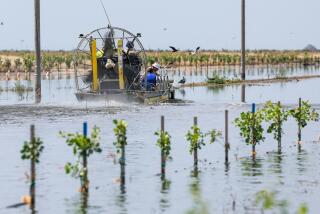Want a Record Fish? Lake Perris Is Place to Try : Three of Six Spotted Bass World Marks Taken From the Riverside County Facility
Want to catch a world record fish? It’s a longshot anytime, anywhere . . . but maybe not quite so long these days at Lake Perris, in Riverside County.
In the last week, three Alabama spotted bass, each weighing better than nine pounds, have been caught there. One of them, a 9-pound 4.5-ounce fish caught by Steve West of Riverside, betters the listed all-tackle world record. In fact, all three fish do.
Lake Perris’ Alabama spotted bass came to California in January of 1974. Alabama gave 94 brood stock fish to California, which stocked them in the lake, the Southern California terminus of the 603-mile-long State Water Project.
From that first stocking, a trophy fishery grew. Through 1986, according to fishing’s record-keeper, the International Game Fish Assn., three of the six listed world-record spotted bass were caught at Perris. The largest, a fish weighing exactly nine pounds, was caught in 1984 by Jeff Mathews of Redlands.
Alabama spotted bass seemed to be just the ticket for a lot of Southern California’s reservoirs, where water levels often fluctuate wildly. Spotted bass spawn in deeper water than do largemouth bass, whose springtime nests are often left high and dry by reduced reservoir water levels.
“Largemouth bass will spawn in depths as shallow as 18 inches,” said DFG biologist Ken Aasen, the man who proposed the spotted bass Perris stocking. “But Alabama spotted bass, on the average, will spawn at 40-inch depths.”
In the last two years, the Perris spotted bass fishery seemed to be in a decline. Fewer big bass were being caught, and biologists blamed three factors:
--Fishing pressure on trophy-size fish was deemed too heavy, so the bag limit was reduced from five fish to two, with a 15-inch minimum size.
--Spotted bass habitat had been invaded, it was found, by a minnow-type fish, silversides, that grew rapidly in numbers and became an effective competitor for the same food sources as the spotted bass.
--An aerator at the reservoir’s dam was found to be operating improperly, a problem since corrected.
And Lake Perris seemed this week to be what it once was--a world-class fishery.
First, Riverside fisherman Maurice Holybee caught a 9-pound 1.28-ounce spotted bass Jan. 22, the second nine-pounder ever caught at the reservoir.
Then West caught his world record-breaker, the 9-pound 4.5-ounce fish. West kept the fish alive on his boat, weighed it, then released it.
On the same day, Rick Stivers of Rancho Cucamonga caught a 9-1 spotted bass.
Spotted bass, which evolved in the Ohio and Mississippi river drainages, were first introduced in California in the 1930s. In Southern California, the fish are also found in San Vicente Lake in San Diego County, Santa Fe Reservoir near Duarte, Pine Flat and Millerton reservoirs near Fresno, and in Lake Isabella in the southern Sierra Nevada.
Spotted bass are smaller than their cousins, largemouth and smallmouth bass, differing most markedly from them by the distinctive, diamond-shaped dark spots on their sides.
They also differ significantly in one important behavioral trait. Adult Alabama spotted bass will not defend their nests when raided by predators, as will largemouth and smallmouth bass.






